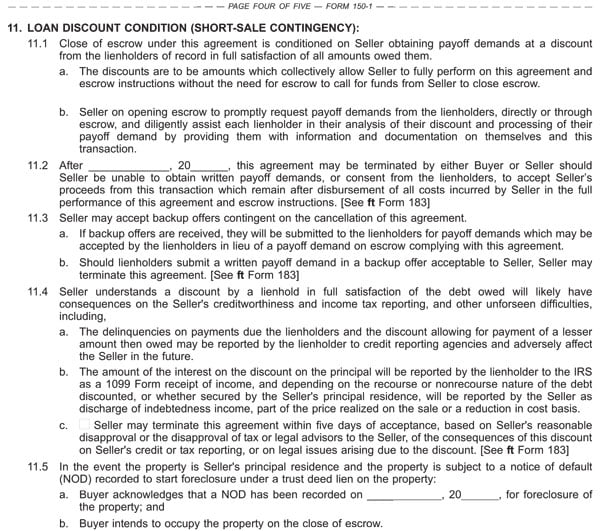Purchase agreements; both conventional and equity purchase, modified for shortsales
This article reviews the two shortsale variations for an offer to purchase negative equity real estate conditioned on the lenders’ acceptance of a discounted payoff amount.
Distinguished by an NOD
Large swaths of California’s 2.5 million negative equity homeowners desire to dispose of their underwater homes and rid themselves of corrosive mortgage debt decimating their balance sheets. Thus, the shortsale has become a ubiquitous feature on the home resale landscape, particularly in California, and a vitally important way for agents to keep practicing in this stilted market. For perspective, approximately one in six multiple listing service (MLS) sales transactions in California is a shortsale today.
The distinguishing fact for an agent’s selection of the type of purchase agreement to be used in the preparation of an offer for a buyer to acquire a seller-occupied single family residence (SFR) is whether or not the property is the subject of a recorded Notice of Default (NOD), and thus in foreclosure.
On determining the existence of an NOD on title, the next pivotal fact is whether the principal balance on the mortgage(s) of record exceeds the price the buyer is willing to offer for the property. If negative equity exists, the seller’s agent will prudently include that information in any MLS or other release of information on the property. [For more information on timely disclosures and the agency case of the decade, see the November 2010 first tuesday article, Holmes v. Summer: dilatory disclosures and the damage done.]
When the one-to-four unit SFR is not in foreclosure under a recorded NOD and is not underwater, the conventional purchase agreement, first tuesday Form 150, is used by brokers and their agents to prepare and submit a buyer’s written offer to purchase. There is no concern with the issue of whether the buyer is an investor or an owner-occupant. [See first tuesday Form 150]
The conventional purchase agreement with shortsale provision
If the SFR has a negative equity but is not in foreclosure, a conventional purchase agreement with a shortsale provision, first tuesday Form 150-1, is used to submit the buyer’s offer to purchase the property. The shortsale provision conditionalizes the seller’s closing of escrow on obtaining a written payoff demand from his mortgage lender at a discount and in full satisfaction of all amounts owed the lender. [See first tuesday Form 150-1 § 11.1]
Through a payoff demand, the lender agrees to accept the seller’s net sales proceeds on the price to be paid by a buyer, an amount lower than the lender’s outstanding mortgage balance. [For an analysis of the process of qualifying a negative equity homeowner for a shortsale with his mortgage lender’s loss mitigation officer, see the September 2011 first tuesday article, You’re sure you’re a shortsale specialist?]
The purchase agreement offer with the shortsale contingency provision becomes a binding written contract between the buyer and seller on acceptance. However, if the seller is unable to obtain payoff demands from the lender(s) who hold his trust deed loan(s) on the property, the agreement may be terminated and rendered unenforceable at the discretion of either the buyer or seller. [See Form 150-1 § 11.2]
Form 150-1 is a comprehensive “boilerplate” purchase agreement with additional and modified provisions specific to shortsale arrangements. Form 150-1 serves as a checklist presenting the various conventional financing arrangements available to the buyer to fund the purchase price and conditions a prudent buyer and his agent would consider when making an offer to purchase. As for the seller, his performance is conditioned on the acceptance of a reduced payoff amount by the lenders who hold the loans.
The equity purchase agreement with shortsale provision
A differently provisioned purchase agreement must be used for submitting an offer if all the following conditions exist:
- the SFR for sale is an owner-occupied, one-to-four unit residential property;
- the SFR is the subject of a recorded NOD (the property is in foreclosure); and
- the buyer is acquiring the property for rental, investment or dealer purposes.
By the existence of these three conditions, equity purchase (EP) laws are triggered which must be complied with when submitting an offer – and are ignored at the broker’s and agent’s great peril. Here, the buyer is an EP investor, not a buyer who will occupy the property, while the seller is referred to as an owner-in-foreclosure.
Now further consider the owner-in-foreclosure whose home has a negative equity condition. An EP investor acquiring an SFR from an owner-in-foreclosure (after an NOD has been recorded) which is over-encumbered requires shortsale arrangements to be approved by the owner’s mortgage lender, in which case the agent uses the EP agreement which contains a shortsale contingency provision. [See first tuesday Form 156-1 § 11]
For a further discussion of the shortselling process and additional details regarding how to submit a purchase agreement with shortsale and EP contingencies together with the paperwork needed by the lender’s loss mitigation officer for approval, see the September 2011 first tuesday article, How to facilitate a shortsale transaction.
Shortsale addendum
Alternatively, brokers and agents may structure the shortsale transaction using the conventional purchase agreement, first tuesday Form 150, or conventional EP agreement, first tuesday Form 156, and attach a shortsale addendum containing the loan discount approval language. [See first tuesday Form 274]
The shortsale addendum mirrors the shortsale contingency contained in the two shortsale variations, and is to be used as an alternative to the shortsale variations, not in conjunction with them.
Your fees under a shortsale
On closing the sale, the fee may be split with a shortsale negotiator who corresponds with the lender and works on getting the shortsale approved. A shortsale negotiator may lawfully be paid a fee by any party to a shortsale if:
- the shortsale negotiator holds a Department of Real Estate (DRE) license;
- the negotiator fee is disclosed in writing to the buyer, seller, lender and all brokers involved, ideally through purchase agreements, escrow instructions or separate fee disclosure forms [first tuesday Form 119]; and
- the fee is stated in the HUD-1 closing statement prepared by escrow.
The fee earned by the negotiator is typically paid by the seller’s agent. However, it may be negotiated to be paid by the buyer, the buyer’s agent or a combination of parties. Depending on the agreement between the parties, the third-party shortsale negotiator can be paid in addition to or from the fees paid by the seller under the listing agreement, so long as the service was not contemplated to be rendered as part of the broker services under the listing agreements.
The most common arrangements involve the seller’s agent paying the negotiator out of his own pocket, then taking a 3.5% share of an industry standard 6% fee to offset the cost, with the remaining 2.5% going to the buyer’s agent.
As no one broker is involved in the lender negotiations, it would be most equitable to deduct the negotiator’s fee from the total fee paid by the seller on the transaction, then split the remaining fee 50/50 between the two brokers. [See the September 2011 first tuesday article, How to facilitate a shortsale transaction.]
Editor’s note – All first tuesday Purchase Agreements have been updated to reference the buyer’s receipt and approval of homeowners’ association (HOA) documents to inform the buyer of operating restrictions and the financial impact of assessment obligations, effective January 1, 2012. [For more information, see the February 2012 first tuesday Form of the Month.]
Click the corresponding form title to download a FREE copy of the form enabled for users to digitally fill, print and save.
- Purchase Agreement (One-to-Four Residential Units – With Shortsale Contingency) [See first tuesday Form 150-1]
- Equity Purchase Agreement – With Shortsale Contingency [See first tuesday Form 156-1]















Ann Sciascia Galanakis,
A foreclosure and a shortsale start with the same triggering event: a negative equity homeowner defaults on the loan securing his home, whether the homeowner is unable or unwilling to pay (as in a strategic default).
If the homeowner makes no attempt to sell the property after he defaults, the lender will foreclose on the property, selling it to satisfy the homeowner’s debt. The homeowner must vacate the property when the foreclosure sale is complete.
Following the homeowner’s default on the loan, he may instead choose to find a buyer for the property at market value. Due to the homeowner’s negative equity in the home, its market value is less than the lender’s loan on the property. Thus, before the sale can go forward, the lender must agree to accept less than the total amount owed by the homeowner, called a shortsale. The homeowner vacates the property on the close of the short sale.
Either way, the property is sold and the homeowner is out of the property, receiving nothing from either the foreclosure sale or the shortsale. The difference is a matter of when the lender is paid: on foreclosure and resale by the lender, or on close of the shortsale escrow.
The real question is this: why are so many people choosing a short sale, and why are lenders simply not reducing principal to avoid foreclosing, taking ownership and reselling the property to receive roughly the same amount of payoff?
Read more about it here: http://journalbeta.firsttuesday.us/short-sale-or-foreclosure-the-naked-truth-for-underwater-homeowners/ and here: http://journalbeta.firsttuesday.us/cramdowns-shot-down-another-missed-opportunity/
Exactly what is a short sale compared to a foreclosure I am so confused